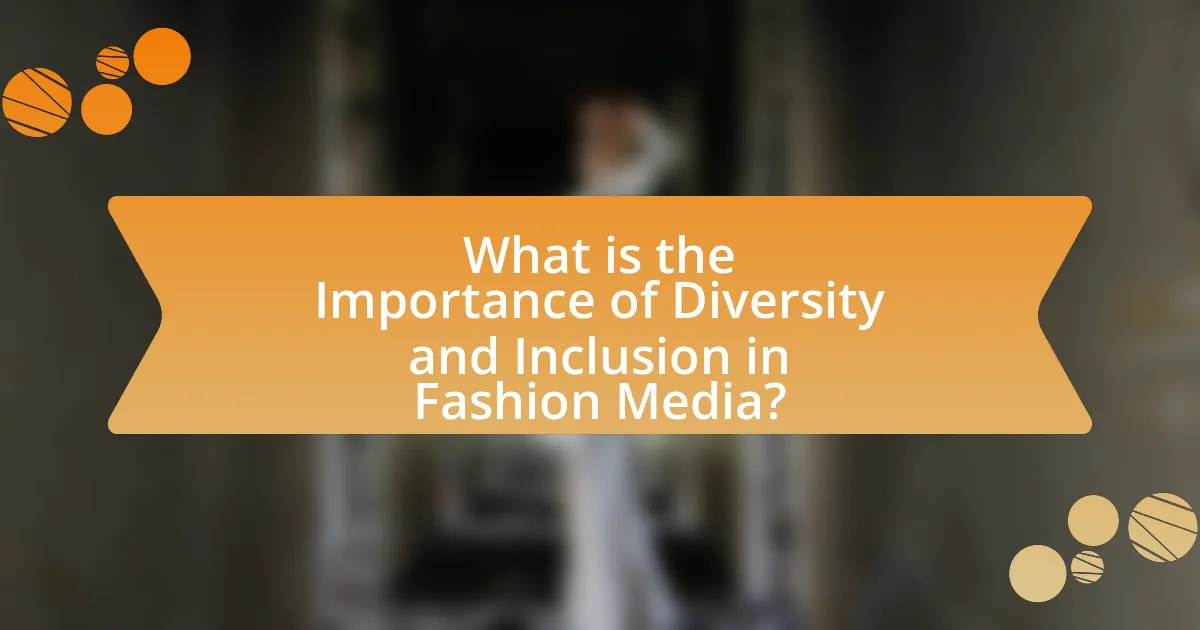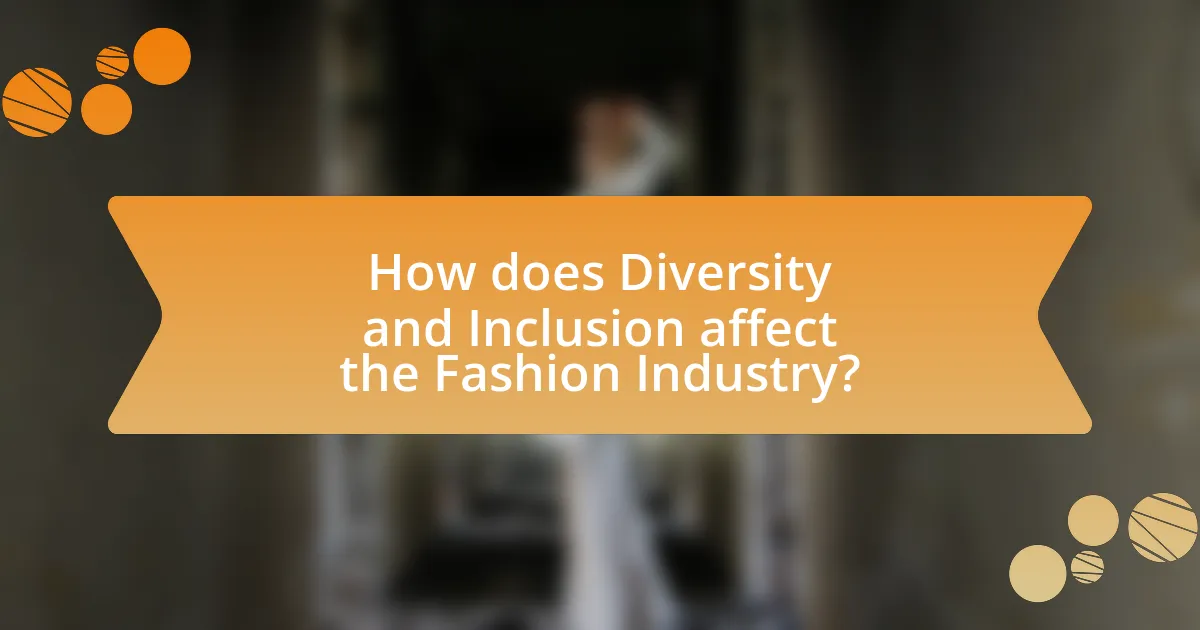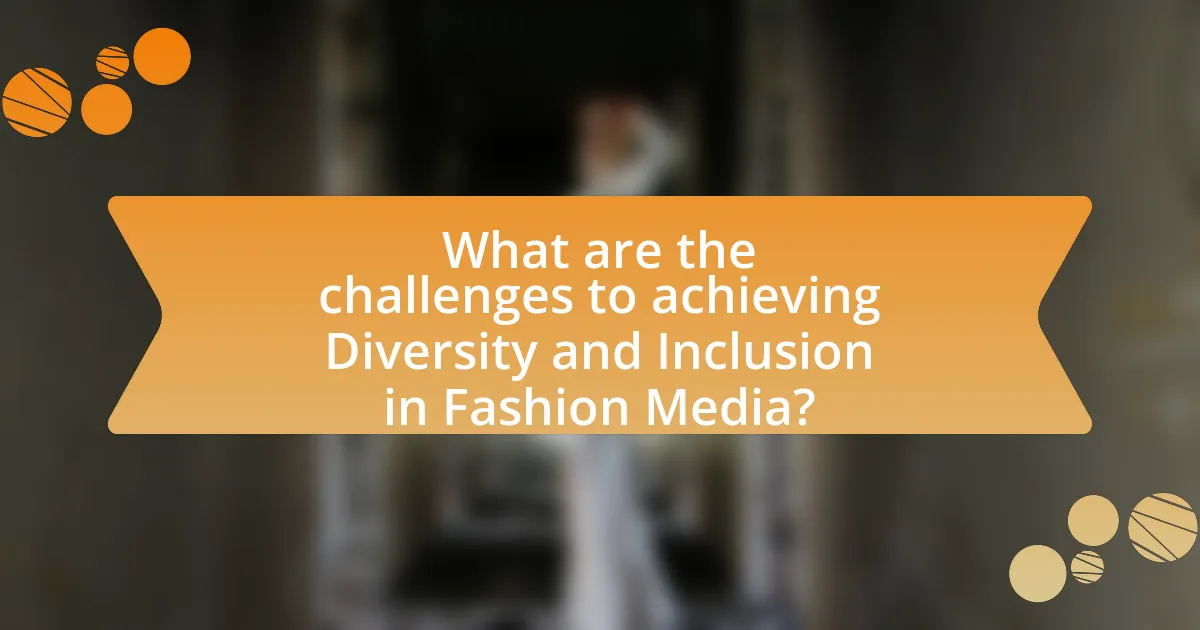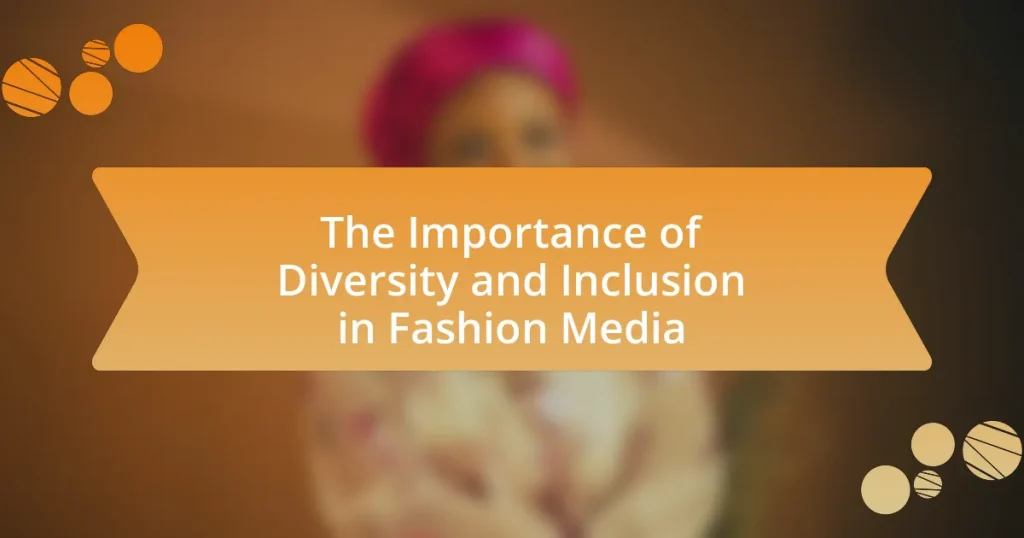The article focuses on the significance of diversity and inclusion in fashion media, emphasizing their role in accurately representing society’s multifaceted nature. It highlights how diverse representation fosters consumer engagement, brand loyalty, and financial performance, with studies indicating substantial increases in sales and trust for brands that embrace inclusivity. The historical context of diversity in fashion media is explored, alongside the impact of representation on audience perception and the creative innovation it inspires. Additionally, the article addresses the challenges to achieving diversity, the role of industry gatekeepers, and practical steps for individuals and professionals to promote inclusivity within the fashion media landscape.

What is the Importance of Diversity and Inclusion in Fashion Media?
Diversity and inclusion in fashion media are crucial for accurately representing the multifaceted nature of society. This representation fosters a sense of belonging among various demographics, which is essential for consumer engagement and brand loyalty. Research indicates that brands embracing diversity can see a 35% increase in financial performance, as highlighted in a McKinsey report. Furthermore, inclusive fashion media challenges stereotypes and promotes positive social change, making the industry more relatable and accessible to a broader audience.
Why is diversity crucial in the fashion media landscape?
Diversity is crucial in the fashion media landscape because it ensures representation of various cultures, body types, and identities, which reflects the reality of a global audience. This representation fosters inclusivity, allowing consumers to see themselves in the media, thereby enhancing brand loyalty and engagement. Studies show that brands with diverse representation in their marketing campaigns experience a 20% increase in consumer trust and a 25% increase in sales, highlighting the economic benefits of diversity. Furthermore, diverse perspectives in fashion media drive innovation and creativity, leading to fresh ideas and trends that resonate with a broader audience.
What historical context has shaped the current state of diversity in fashion media?
The current state of diversity in fashion media has been shaped by historical movements advocating for civil rights and representation. The 1960s civil rights movement in the United States, for instance, highlighted racial inequalities and pushed for greater representation of marginalized communities in various sectors, including fashion. This led to the inclusion of models of diverse backgrounds in fashion shows and magazines, exemplified by the groundbreaking work of models like Naomi Campbell and Iman in the 1980s and 1990s, who challenged the predominantly white standards of beauty. Additionally, the feminist movements of the 1970s and 1980s called for gender equality, influencing fashion media to showcase a broader range of female identities and body types. The rise of social media in the 2000s further democratized fashion media, allowing diverse voices and perspectives to emerge, thus reshaping industry standards and expectations. These historical contexts collectively contributed to the ongoing evolution towards inclusivity and representation in fashion media today.
How does representation impact audience perception in fashion media?
Representation significantly impacts audience perception in fashion media by shaping societal norms and influencing individual self-image. When diverse body types, ethnicities, and gender identities are represented, it fosters a sense of belonging and validation among audiences, leading to increased acceptance of varied beauty standards. Research indicates that exposure to diverse representations can enhance body positivity and reduce feelings of inadequacy; for instance, a study published in the Journal of Consumer Research found that individuals exposed to diverse models reported higher self-esteem and body satisfaction. Thus, representation in fashion media not only reflects societal diversity but also actively contributes to reshaping audience perceptions and promoting inclusivity.
What role does inclusion play in fashion media?
Inclusion plays a crucial role in fashion media by promoting representation and diversity, which enhances the industry’s relevance and relatability to a broader audience. By showcasing a variety of body types, ethnicities, genders, and ages, fashion media can challenge traditional beauty standards and foster a more inclusive culture. Research indicates that brands embracing diversity see increased consumer loyalty and engagement; for instance, a study by McKinsey & Company found that companies with more diverse workforces are 35% more likely to outperform their competitors. This demonstrates that inclusion not only reflects societal values but also drives business success in the fashion industry.
How can inclusion enhance creativity and innovation in fashion media?
Inclusion enhances creativity and innovation in fashion media by bringing diverse perspectives that challenge conventional norms and inspire new ideas. When individuals from various backgrounds contribute, they introduce unique cultural insights and experiences, which can lead to innovative storytelling and design concepts. For instance, a study by McKinsey & Company found that companies with diverse leadership teams are 35% more likely to outperform their industry medians in terms of financial returns, indicating that diversity drives better decision-making and creativity. This diversity in thought and experience fosters an environment where innovative solutions can thrive, ultimately enriching the fashion media landscape.
What are the consequences of exclusion in fashion media narratives?
Exclusion in fashion media narratives leads to a lack of representation, which can perpetuate stereotypes and limit the diversity of beauty standards. This absence of varied perspectives can alienate consumers who do not see themselves reflected in media portrayals, resulting in decreased brand loyalty and engagement. Research indicates that brands with inclusive marketing strategies experience a 33% increase in customer loyalty, highlighting the financial implications of exclusion. Furthermore, the lack of diverse narratives can contribute to mental health issues among marginalized groups, as they may feel undervalued and invisible in a culture that prioritizes certain aesthetics over others.

How does Diversity and Inclusion affect the Fashion Industry?
Diversity and inclusion significantly enhance the fashion industry by fostering creativity, broadening market appeal, and improving brand loyalty. When fashion brands embrace diverse perspectives, they can create innovative designs that resonate with a wider audience, reflecting the varied cultural backgrounds and identities of consumers. For instance, a 2020 McKinsey report highlighted that companies in the fashion sector with higher diversity levels are 36% more likely to outperform their competitors in profitability. Additionally, inclusive marketing strategies attract diverse consumer bases, leading to increased sales and customer retention. This shift towards diversity and inclusion not only aligns with societal values but also positions brands as leaders in a rapidly evolving market.
What are the benefits of diverse representation in fashion media?
Diverse representation in fashion media enhances inclusivity, promotes cultural understanding, and drives market growth. By showcasing a variety of body types, ethnicities, and gender identities, fashion media reflects the real-world diversity of consumers, fostering a sense of belonging and acceptance. Research indicates that brands with diverse representation can increase their market share; for instance, a study by McKinsey & Company found that companies in the top quartile for ethnic diversity on executive teams were 36% more likely to outperform their peers in profitability. Furthermore, diverse representation can challenge stereotypes and broaden the narrative around beauty, leading to more innovative and relatable content that resonates with a wider audience.
How does diverse representation influence consumer behavior?
Diverse representation significantly influences consumer behavior by fostering a sense of belonging and relatability among various demographic groups. When consumers see individuals who reflect their own identities in marketing and media, they are more likely to engage with the brand, leading to increased loyalty and purchasing intent. Research from the 2020 “Diversity in Advertising” report by the Association of National Advertisers found that 67% of consumers are more likely to purchase from brands that represent diversity in their advertising. This correlation indicates that diverse representation not only enhances brand perception but also drives sales by appealing to a broader audience.
What impact does diversity have on brand loyalty and trust?
Diversity positively impacts brand loyalty and trust by fostering a sense of inclusion among consumers. When brands reflect diverse identities and experiences, they resonate more deeply with a broader audience, leading to increased emotional connections. Research from the Harvard Business Review indicates that companies with diverse leadership teams are 33% more likely to outperform their peers in profitability, demonstrating that diversity not only enhances brand perception but also drives consumer loyalty. Furthermore, a study by McKinsey found that brands perceived as inclusive can achieve higher customer satisfaction rates, reinforcing trust and loyalty among diverse consumer segments.
How can fashion media promote inclusivity?
Fashion media can promote inclusivity by showcasing diverse models and narratives that reflect a wide range of identities, body types, and cultural backgrounds. This approach not only broadens representation but also challenges traditional beauty standards, fostering a more inclusive environment. For instance, campaigns like Aerie’s #AerieREAL have successfully featured unretouched images of models of various sizes and ethnicities, resulting in increased consumer engagement and brand loyalty. Additionally, fashion media can highlight stories and perspectives from underrepresented communities, thereby amplifying voices that are often marginalized in mainstream fashion discourse.
What strategies can be implemented to ensure diverse voices are heard?
To ensure diverse voices are heard in fashion media, implementing inclusive hiring practices is essential. This involves actively recruiting individuals from various backgrounds, including different races, genders, and socioeconomic statuses, to create a representative workforce. Research by McKinsey & Company shows that companies with diverse teams are 35% more likely to outperform their less diverse counterparts, highlighting the value of varied perspectives. Additionally, establishing platforms for marginalized voices, such as dedicated sections in publications or social media campaigns, can amplify underrepresented narratives. This approach not only enriches content but also fosters a sense of belonging among diverse audiences, ultimately leading to a more inclusive fashion media landscape.
How can fashion media organizations measure their inclusivity efforts?
Fashion media organizations can measure their inclusivity efforts by analyzing demographic representation in their content, assessing audience engagement metrics, and conducting surveys to gather feedback on perceived inclusivity. For instance, tracking the diversity of models, designers, and contributors featured in articles and campaigns provides quantitative data on representation. Additionally, engagement metrics such as social media interactions and website analytics can indicate how well diverse content resonates with audiences. Surveys can further reveal audience perceptions of inclusivity, allowing organizations to identify areas for improvement. These methods collectively offer a comprehensive approach to evaluating inclusivity in fashion media.

What are the challenges to achieving Diversity and Inclusion in Fashion Media?
Achieving diversity and inclusion in fashion media faces several significant challenges, including systemic bias, lack of representation, and economic barriers. Systemic bias within the industry often leads to the prioritization of certain beauty standards and narratives, marginalizing diverse voices. For instance, a 2020 report by the Fashion Spot indicated that only 27.9% of models used in major fashion shows were from diverse backgrounds, highlighting the lack of representation. Additionally, economic barriers prevent many diverse creators from accessing opportunities in fashion media, as funding and resources are often concentrated among established brands and individuals. These challenges create a cycle that perpetuates homogeneity in fashion media, making it difficult to achieve true diversity and inclusion.
What barriers exist to diversity in fashion media?
Barriers to diversity in fashion media include systemic biases, lack of representation, and limited access to resources for marginalized groups. Systemic biases manifest in hiring practices and editorial decisions that favor established norms, often sidelining diverse voices. A study by the Fashion Spot in 2020 revealed that only 38.5% of models used in major fashion campaigns were from diverse backgrounds, highlighting the lack of representation. Additionally, marginalized individuals often face challenges in accessing industry networks and funding, which further restricts their ability to participate in fashion media.
How do systemic issues affect diversity in fashion media?
Systemic issues significantly limit diversity in fashion media by perpetuating narrow standards of beauty and representation. These issues include economic barriers, lack of access to resources, and entrenched biases within the industry, which collectively hinder the inclusion of diverse voices and perspectives. For instance, a 2020 report by the Fashion Spot revealed that only 27.9% of models used in major fashion campaigns were people of color, highlighting the ongoing racial disparity. Furthermore, systemic inequalities in hiring practices often result in predominantly white leadership in fashion media, which influences the narratives and aesthetics that are prioritized. This lack of diversity not only affects the representation of various cultures and identities but also restricts the industry’s ability to connect with a broader audience, ultimately impacting its relevance and growth.
What role do industry gatekeepers play in maintaining the status quo?
Industry gatekeepers play a crucial role in maintaining the status quo by controlling access to resources, opportunities, and platforms within the fashion media landscape. These gatekeepers, such as editors, producers, and influencers, often prioritize established norms and traditional narratives, which can limit the representation of diverse voices and perspectives. For instance, a study by the Fashion Institute of Technology found that 78% of fashion media content predominantly features a narrow demographic, reinforcing existing biases and hindering inclusivity. This concentration of power among gatekeepers perpetuates a cycle where only certain narratives are amplified, thereby sustaining the status quo in fashion media.
How can these challenges be overcome?
To overcome challenges in achieving diversity and inclusion in fashion media, organizations must implement comprehensive strategies that prioritize representation and equitable practices. This can be achieved by actively recruiting diverse talent across all levels of the industry, ensuring that decision-makers reflect a variety of backgrounds and perspectives. Research from the Fashion Institute of Technology indicates that brands with diverse leadership teams are 35% more likely to outperform their competitors in terms of profitability. Additionally, fostering an inclusive culture through training programs and awareness initiatives can help dismantle biases and promote understanding among employees. By establishing clear metrics for diversity goals and regularly assessing progress, fashion media can create a more inclusive environment that resonates with a broader audience.
What initiatives have been successful in promoting diversity in fashion media?
Successful initiatives promoting diversity in fashion media include the establishment of programs like the Diversity Coalition, which aims to increase representation of marginalized groups in fashion publications. Additionally, campaigns such as #BlackAndFashion and #FashionForAll have raised awareness and encouraged brands to feature diverse models and stories. Research by the Council of Fashion Designers of America (CFDA) indicates that brands embracing diversity see improved consumer engagement and loyalty, highlighting the effectiveness of these initiatives in reshaping industry standards.
How can collaboration among stakeholders drive change in fashion media?
Collaboration among stakeholders can drive change in fashion media by fostering diverse perspectives and inclusive practices. When brands, designers, media outlets, and consumers work together, they can challenge traditional narratives and promote representation across various demographics. For instance, initiatives like the “Diversity in Fashion” campaign have shown that when stakeholders unite, they can amplify underrepresented voices, leading to a broader acceptance of diverse beauty standards. This collaborative approach not only enhances the authenticity of fashion media but also aligns with consumer demand for inclusivity, as evidenced by a 2021 survey indicating that 67% of consumers prefer brands that demonstrate diversity in their marketing.
What practical steps can individuals take to support diversity and inclusion in fashion media?
Individuals can support diversity and inclusion in fashion media by actively promoting and sharing content that features diverse voices and perspectives. This can be achieved by following and amplifying the work of designers, models, and influencers from underrepresented backgrounds on social media platforms. Additionally, individuals can advocate for inclusive representation by engaging with brands that prioritize diversity in their campaigns and by participating in discussions that challenge stereotypes and biases within the industry. Research indicates that diverse representation in media not only reflects societal realities but also enhances brand loyalty and consumer engagement, as seen in a study by McKinsey & Company, which found that companies with more diverse teams are 35% more likely to outperform their competitors.
How can consumers advocate for more inclusive fashion media representation?
Consumers can advocate for more inclusive fashion media representation by actively supporting brands and media outlets that prioritize diversity in their campaigns and content. By choosing to purchase from companies that showcase a wide range of body types, ethnicities, and gender identities, consumers send a clear message that inclusivity is valued. Research indicates that 67% of consumers believe that brands should represent a diverse range of people in their advertising, highlighting the demand for change. Additionally, consumers can utilize social media platforms to voice their opinions, share content that promotes inclusivity, and engage in discussions that challenge traditional beauty standards. This collective action can influence brands to adopt more inclusive practices, ultimately reshaping the fashion media landscape.
What actions can fashion professionals take to foster an inclusive environment?
Fashion professionals can foster an inclusive environment by actively promoting diversity in their hiring practices and representation. This includes recruiting individuals from various backgrounds, ethnicities, genders, and body types to ensure that the workforce reflects the diversity of the consumer base. Research indicates that companies with diverse teams are 35% more likely to outperform their competitors, highlighting the business case for inclusivity. Additionally, fashion professionals should implement training programs focused on cultural competency and unconscious bias to educate their teams about the importance of inclusivity. By creating platforms for underrepresented voices and collaborating with diverse designers, fashion professionals can further enhance representation in their collections and campaigns, thereby fostering a more inclusive industry.



